
There are some recipes you cook because you need to eat, and then there are recipes you cook because you want a small event at the table. A good chicken katsu curry recipe always feels like the second kind. You get the sizzle of hot oil, the comfort of a thick Japanese-style curry, and a mound of rice that soaks it all up.
In this post we’ll walk through a detailed, home-cook-friendly chicken katsu curry recipe, then build out variations: pork and tofu versions, air-fryer and lighter “fakeaway” spins, plus quick cheats using curry roux. You’ll also see ideas for what to serve alongside, how to turn leftovers into entirely new meals, and a bit of backstory on how this dish went from Tokyo comfort food to global obsession.
What exactly is chicken katsu curry?
In Japan, katsu curry means curry rice served with a breaded, fried cutlet on top. The cutlet is the “katsu” (usually pork, sometimes chicken), and the curry is a thick, mellow, slightly sweet Japanese-style sauce ladled over rice. According to the entry on katsu curry, the dish is typically built as rice on one side, curry sauce on the other, and sliced cutlet laid neatly across.
Unlike many Indian curries, Japanese curry is usually based on a roux: flour and fat cooked together with curry spices, then loosened with stock to form a glossy, spoon-coating sauce. Over time, Japanese manufacturers turned that idea into the curry roux blocks you see in Asian supermarkets. Writers like Nagi from RecipeTin Japan break down how home cooks now rely on these blocks to make a quick katsu curry with chicken cutlet, using them much like we use bouillon cubes.

Origins of Japanese chicken katsu curry and its recipe
The origin story often credited for katsu curry is surprisingly specific. One popular telling goes back to Grill Swiss, a Western-style restaurant in Tokyo’s Ginza district. A regular customer complained that ordering curry and tonkatsu separately took too much time, so the kitchen served the cutlet on top of the curry, all on one plate. That little act of laziness birthed a dish that spread across Japan, as explored in an essay on the origins of katsu curry.
Outside Japan, the story takes another turn. In the UK especially, “katsu curry” exploded on high-street menus in the 2000s; JETRO even has a piece on how katsu curry conquered the UK, tracing its rise through chains like Wagamama and Wasabi. Somewhere along the way, people started using “katsu” to mean “any Japanese curry” or even just “that brown katsu sauce,” which isn’t how the term is used in Japan at all.
Here, we’ll lean towards the Japanese understanding: crispy breaded cutlet + Japanese curry + rice. Once that foundation is clear, the rest of the variations fall into place very naturally.
Also Read: Crispy Homemade French Fries From Fresh Potatoes (Recipe Plus Variations)
Ingredients for this chicken katsu curry recipe
To make this chicken katsu curry recipe feel doable on a regular weeknight, it helps to see the dish in three parts:
- The chicken katsu (breaded cutlet)
- The Japanese curry sauce
- Rice and toppings
Once you get comfortable with that structure, you can mix and match ingredients, proteins and cooking methods without getting lost.
Chicken katsu (serves 4)
- 4 small chicken breasts or 2 large, butterflied and pounded to about 1 cm thick
- 1 teaspoon fine salt
- ½ teaspoon ground black or white pepper
- ½ teaspoon garlic powder (optional but tasty)
- 60 g (½ cup) plain flour
- 2 large eggs, beaten
- 120 g (about 2 cups) panko breadcrumbs
- Neutral oil for frying (sunflower, canola, rice bran)
Panko is key here. Regular breadcrumbs will work, but panko gives you that light, craggy crust you see on proper tonkatsu and classic chicken katsu.
Japanese curry sauce
We’ll build a hybrid sauce: part scratch, part shortcut. You can go fully homemade or lean on curry roux blocks when life gets hectic.
- 2 tablespoons neutral oil or butter
- 1 large onion, thinly sliced
- 2 cloves garlic, minced
- 1 teaspoon grated fresh ginger
- 2 medium carrots, cut into chunks
- 2–3 small waxy potatoes, peeled and cubed
- 2 tablespoons plain flour
- 1–2 tablespoons mild curry powder (Japanese curry powder if available)
- ½ teaspoon garam masala (optional)
- 750 ml (3 cups) chicken or vegetable stock
- 1–2 teaspoons soy sauce
- 1–2 teaspoons honey or sugar
- 1 tablespoon grated apple or a splash of apple juice
- Salt to taste
If you prefer, you can replace the flour and curry powder with roughly 4 squares of Japanese curry roux from a pack, stirring them in as described later.
Rice and toppings
- 300–400 g uncooked short-grain Japanese rice (or any medium/short-grain rice you enjoy)
- Finely shredded cabbage
- Sliced spring onions
- Japanese pickles (fukujinzuke, takuan) if you can find them
The contrast of hot, savoury curry sauce with cool, crisp cabbage might seem unusual if you’re used to Indian curries, but once you try it, it makes perfect sense.
Also Read: Simple Bloody Mary Recipe – Classic, Bloody Maria, Virgin & More
Step-by-step chicken katsu curry recipe
Now let’s bring it all together. Although this plate looks impressive, the workflow is surprisingly logical: curry first, rice while it simmers, then katsu at the end so it stays crisp.
Cook the rice
Begin with the rice so it’s ready to welcome everything else. Rinse it in cold water until the water runs mostly clear, then cook in a rice cooker or in a saucepan using the absorption method. The goal is fluffy but slightly sticky grains, similar to what you see in recipes like chicken katsu curry rice from The Woks of Life.
Once it’s done, keep the lid on and the heat off. The rice will stay warm and steam gently while you handle the rest.

Make the Japanese curry sauce
While the rice cooks, start the curry:
Sweat the aromatics
Set a wide saucepan or deep skillet over medium heat and add the oil or butter. Scatter in the sliced onion with a pinch of salt and cook slowly for 8–10 minutes. Stir now and again until the onion softens and turns pale gold. This patient step builds sweetness and depth into your curry.
Add garlic, ginger and vegetables
Stir in the garlic and ginger and cook for about 30 seconds, just until fragrant. Immediately add the carrot and potato chunks, tossing them through the onion mixture for a couple of minutes so they start to absorb those flavours
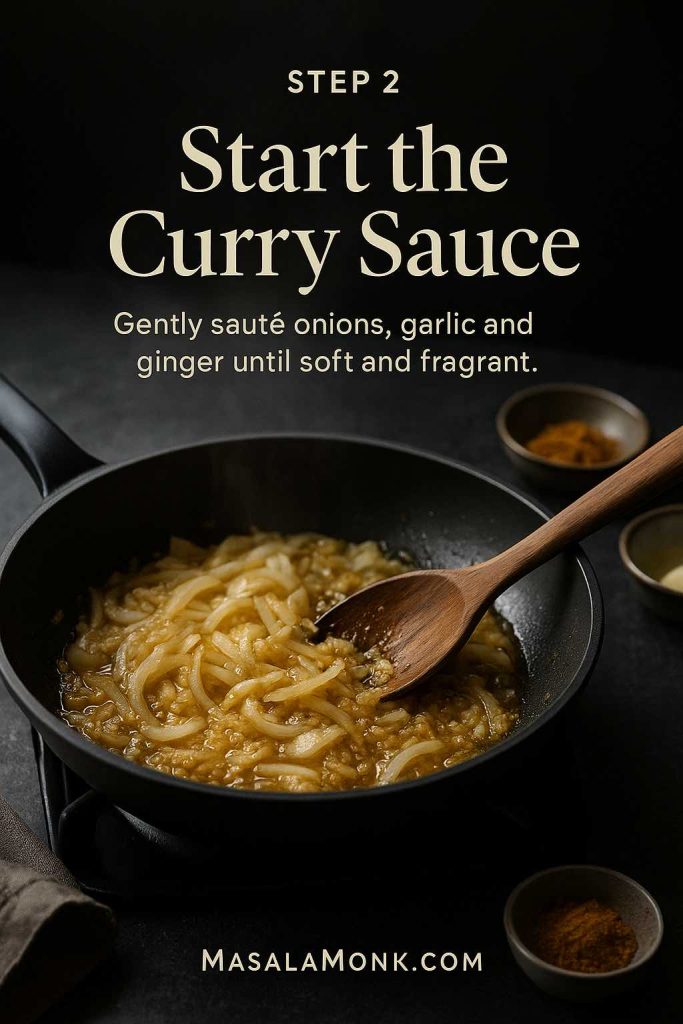
Create a curry roux base
Sprinkle the flour and curry powder over the vegetables. Stir well so everything gets coated and the flour begins to absorb the oil. Let it cook for 1–2 minutes; the mixture will look slightly pasty and stick to the pan. That’s the beginning of your roux.
Build the sauce
Pour in a splash of stock while stirring to release any sticky bits from the bottom, then gradually add the rest, stirring all the while to avoid lumps. Add soy sauce, honey or sugar, and the grated apple. The apple brings gentle sweetness and helps mimic the rounded flavour you get from Japanese curry blocks.
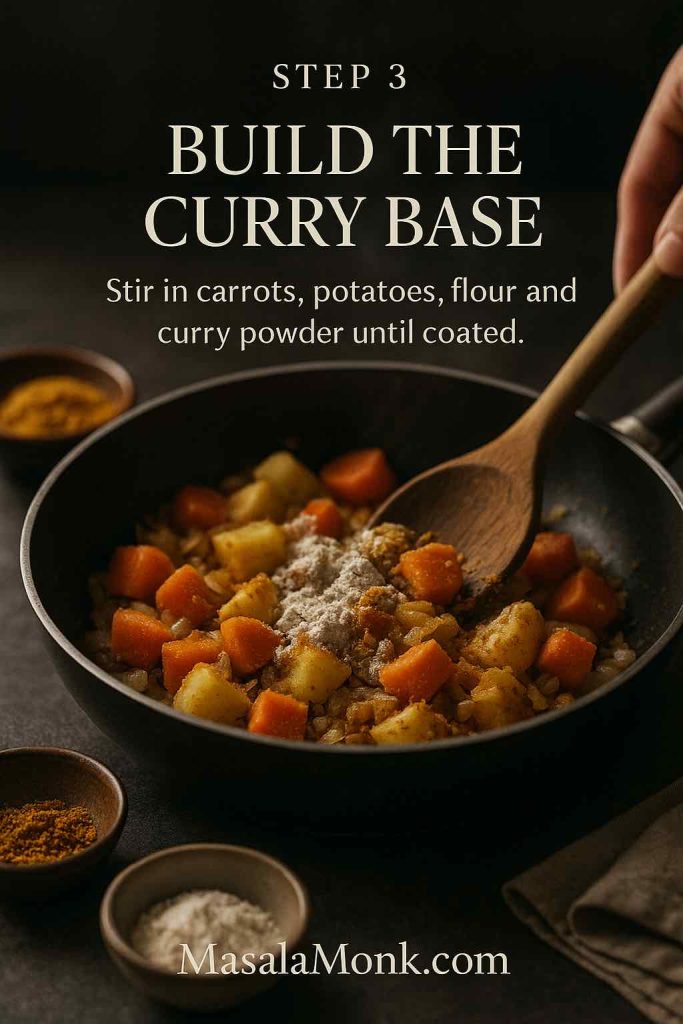
Simmer until tender
Bring the sauce to a gentle simmer, then lower the heat and cook for 15–20 minutes, stirring occasionally. The vegetables should become tender, and the sauce should thicken into a glossy, spoon-coating consistency. If it ever feels too thick, loosen it with a little extra stock or water.
Adjust the seasoning
Taste and tweak. Perhaps it needs a touch more soy for savoury depth, a pinch of salt, or a little extra honey if your curry powder is particularly sharp. For warmth, sprinkle in garam masala towards the end and simmer for another minute.
At this point, you have a solid Japanese curry base. If you’d like a smoother texture, you can mash some of the potato and carrot against the side of the pan or briefly blend a ladleful and stir it back.
Also Read: French 75 Cocktail Recipe: 7 Easy Variations
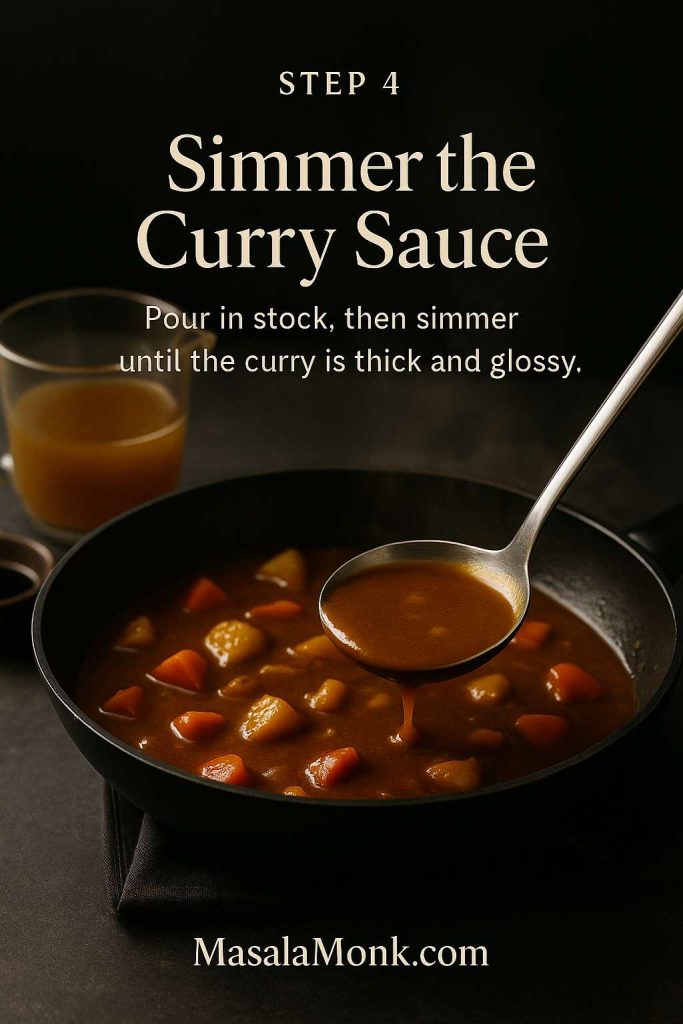
Preparing the chicken katsu
With the curry gently bubbling away, you can turn your attention to the cutlets. This part feels almost like making schnitzel, just with panko and Japanese flavours.
Season and pound the chicken
Lay each chicken breast between two sheets of baking paper or cling film. Gently pound with a rolling pin or meat mallet until it’s an even 1 cm thickness. Even thickness means even cooking and less chance of dry patches.
Season both sides with salt, pepper and garlic powder. Leave the chicken to sit while you set up your breading station; the salt will start to work its way in.
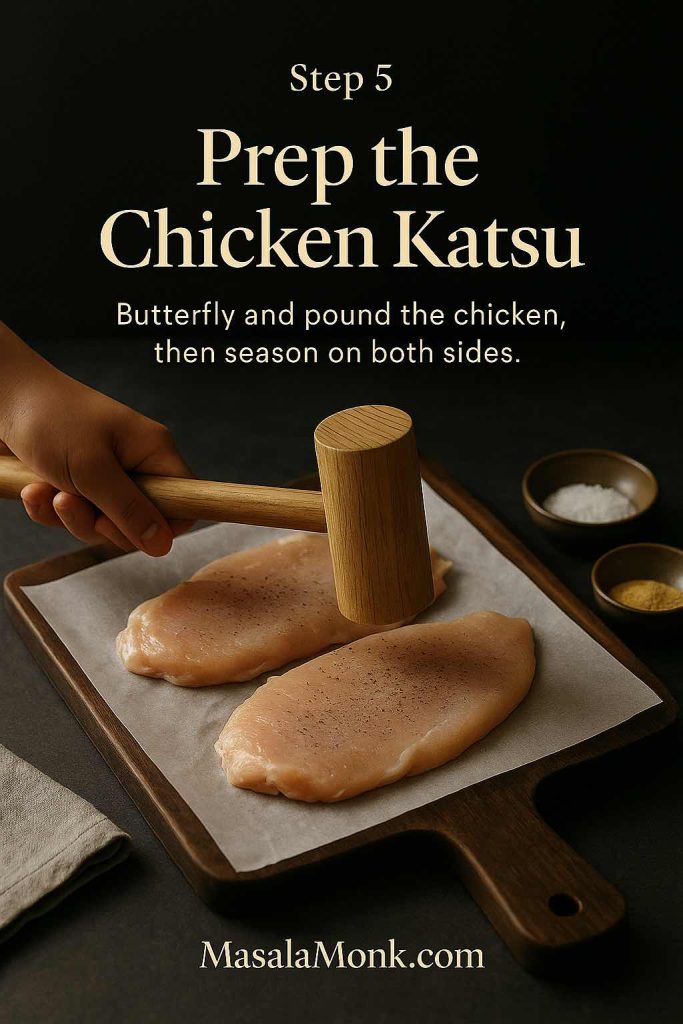
Set up the breading station
Arrange three shallow bowls:
- Flour in the first
- Beaten eggs in the second
- Panko breadcrumbs in the third
To keep the crumbs especially crisp, you can mix a small pinch of salt and a drizzle of oil into the panko. The oil helps them brown more evenly in the pan or air fryer.
Dip each seasoned cutlet into the flour, shaking off excess so only a thin, even layer remains. Then pass it through the beaten egg, letting any drips fall back into the bowl. Finally, press the cutlet into the panko, turning to coat all sides. Press firmly so the crumbs really hug the surface.
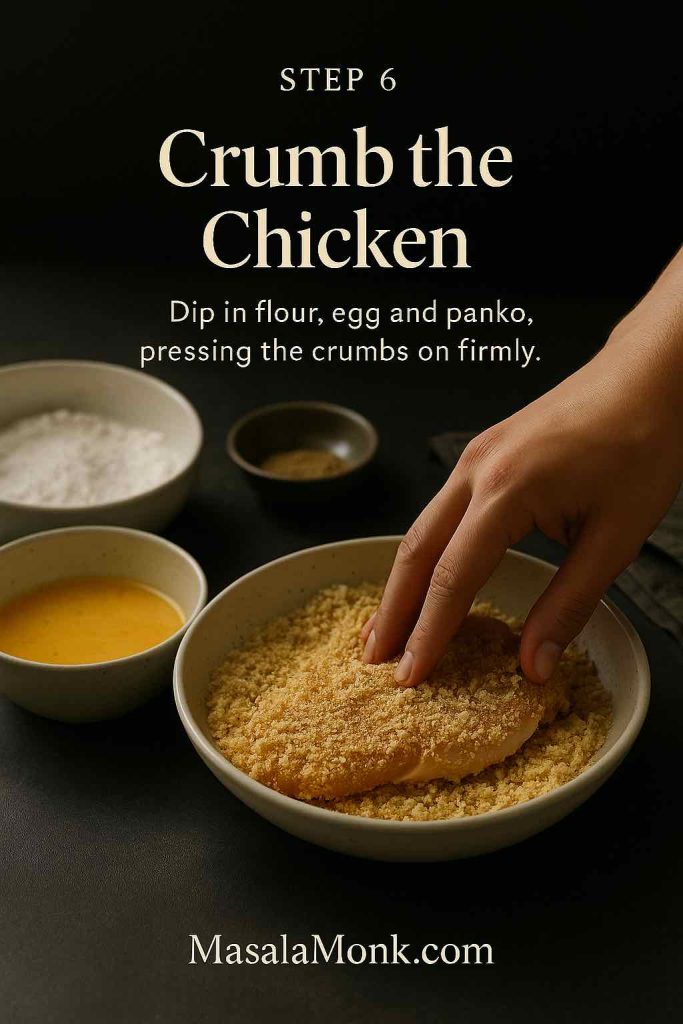
Place the breaded cutlets on a wire rack or plate and let them rest for 5–10 minutes. This pause allows the coating to hydrate slightly and stick better, reducing the risk of it sliding off in the oil.
Frying or air-frying the katsu
A hallmark of any good chicken katsu curry recipe is that contrast between a juicy centre and a shatteringly crisp crust. There are two main paths to get there: traditional frying or a lighter air-fryer version.
Shallow or deep-frying
Set a large skillet or saucepan over medium-high heat and pour in enough oil to reach 1–2 cm up the sides. Heat until a breadcrumb dropped in the oil sizzles immediately and turns golden within about 30 seconds (around 170–180°C).
Carefully lay in the cutlets, two at a time if your pan is large. Fry for roughly 3–4 minutes on the first side until deep golden, then flip and cook another 3–4 minutes. As they fry, adjust the heat to keep the colour even; if they’re browning too quickly, lower the temperature slightly.
Once they’re beautifully golden and cooked through, transfer each cutlet to a rack or paper-towel-lined tray. Sprinkle with a tiny pinch of salt while they’re still hot.
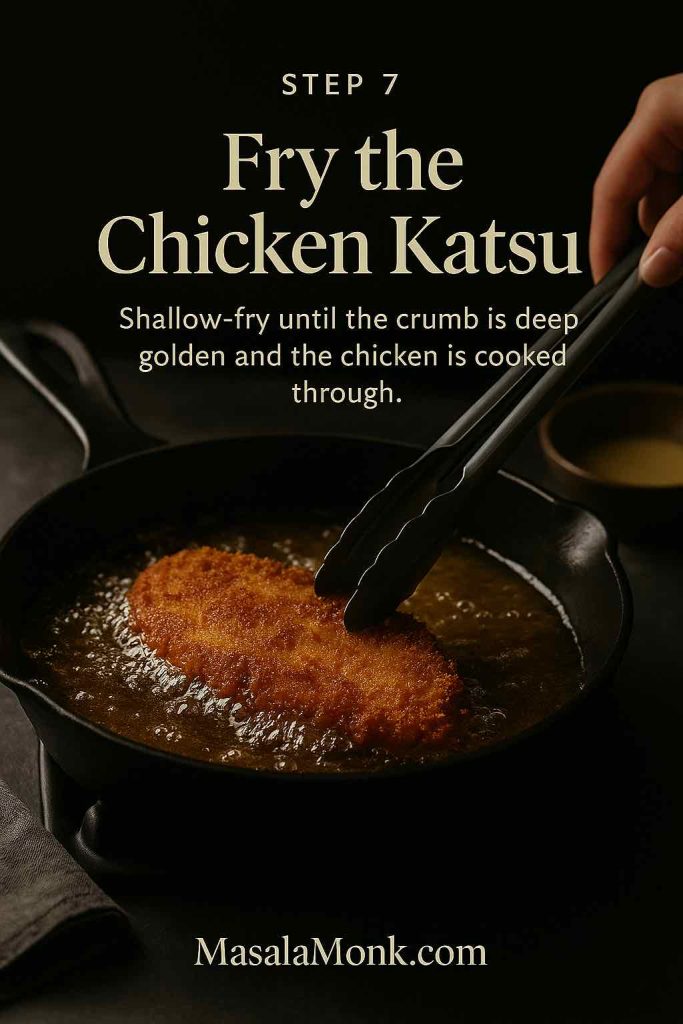
Air-fryer recipe for chicken katsu curry
If you’re craving something lighter without sacrificing crunch, an air fryer is extremely handy. Food bloggers like CJ Eats and Okonomi Kitchen have shown that air fryer chicken katsu and air-fried panko cutlets can emerge every bit as crisp when cooked at around 190–200°C.
To air-fry:
- Lightly mist both sides of each breaded cutlet with oil spray.
- Preheat the air fryer to 190–200°C.
- Arrange the cutlets in a single layer, leaving a little room around each one.
- Cook for 12–15 minutes, flipping halfway, until golden and cooked through.
Because every air fryer model is slightly different, peek a little earlier the first time you make this. Once you’ve dialled in your perfect timing, this method becomes a reliable “fakeaway” option: all the joy, far less grease.
Also Read: Peanut Butter Cookies (Classic Recipe & 3 Variations)
Assembling your bowl of chicken katsu curry
Now comes the best part: putting it all together so every bite has crunch, sauce and rice.
- Slice the katsu
Place each cutlet on a board and slice across on a slight diagonal into 1.5–2 cm strips. Keep the pieces in order so you can re-create that neat “fan” on the plate. - Plate the rice and curry
Spoon a generous mound of rice into a shallow bowl or wide plate. Ladle the hot curry sauce alongside, letting a bit of it seep into the rice but keeping some white patches for contrast. - Lay the katsu on top
Lift the sliced katsu with a wide knife and transfer it onto the plate, arranging it across the curry and rice. You want the bottom edges to catch a little sauce while the tops stay crisp, just like in that idealised katsu curry plate you see in Japanese cookbooks and in dishes like the one on The Woks of Life. - Add fresh toppings
Finish with a tumble of finely shredded cabbage, a sprinkle of sliced spring onions and, if you have them, a spoonful of pickles. The fresh crunch cuts through the richness and keeps the whole dish from feeling heavy.

At this stage, your classic chicken katsu curry recipe is complete. Nevertheless, once you’ve done it once or twice, it’s hard to resist playing with variations.
Also Read: Green Tea Shot with Jameson | Recipe & 10 Variations
Variations on the chicken katsu curry recipe
Because this dish is modular, it’s incredibly forgiving. A small swap in the sauce, a different protein, or a new cooking method can produce a meal that feels distinct without forcing you to learn an entirely new recipe.
Pork katsu curry (tonkatsu)
Strictly speaking, the original Japanese katsu curry is usually made with pork. To follow that path:
- Use boneless pork loin or fillet sliced about 1–1.5 cm thick.
- Pound lightly to even them out.
- Season, bread and cook exactly as you would the chicken.
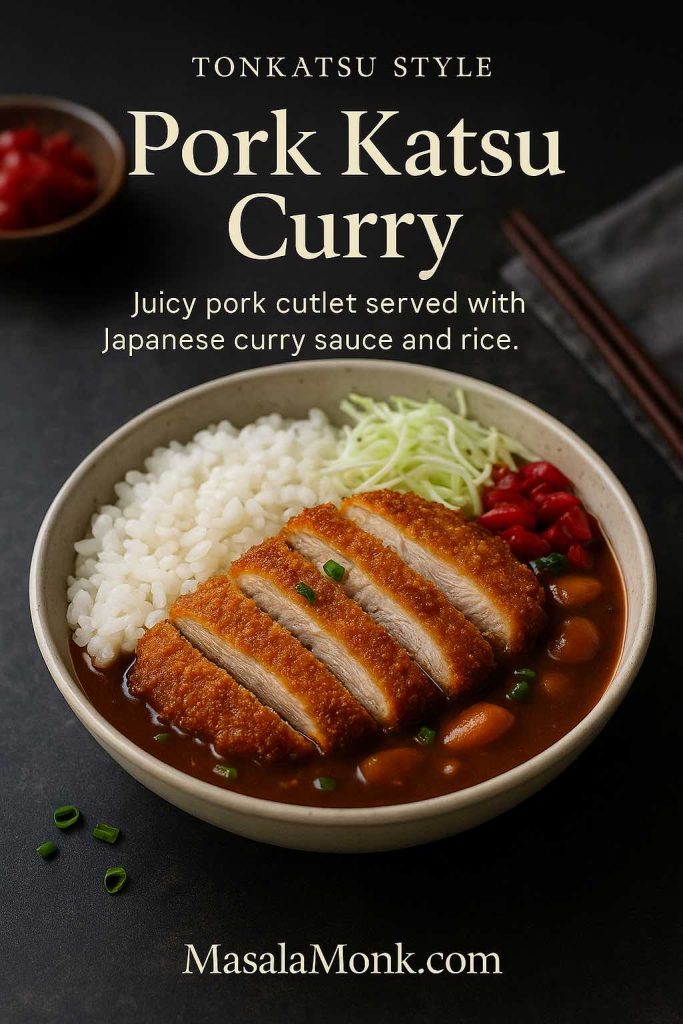
Pork tends to cook slightly faster than chicken breast at the same thickness, so start checking for doneness after 3 minutes per side if you’re shallow-frying. Slice, serve over rice and curry, and you’ve got a comforting tonkatsu curry that leans a little richer and more savoury.
Plain Japanese chicken curry recipe (no katsu)
On evenings when frying feels like too much effort, you can turn this chicken katsu curry recipe into a simpler Japanese chicken curry.
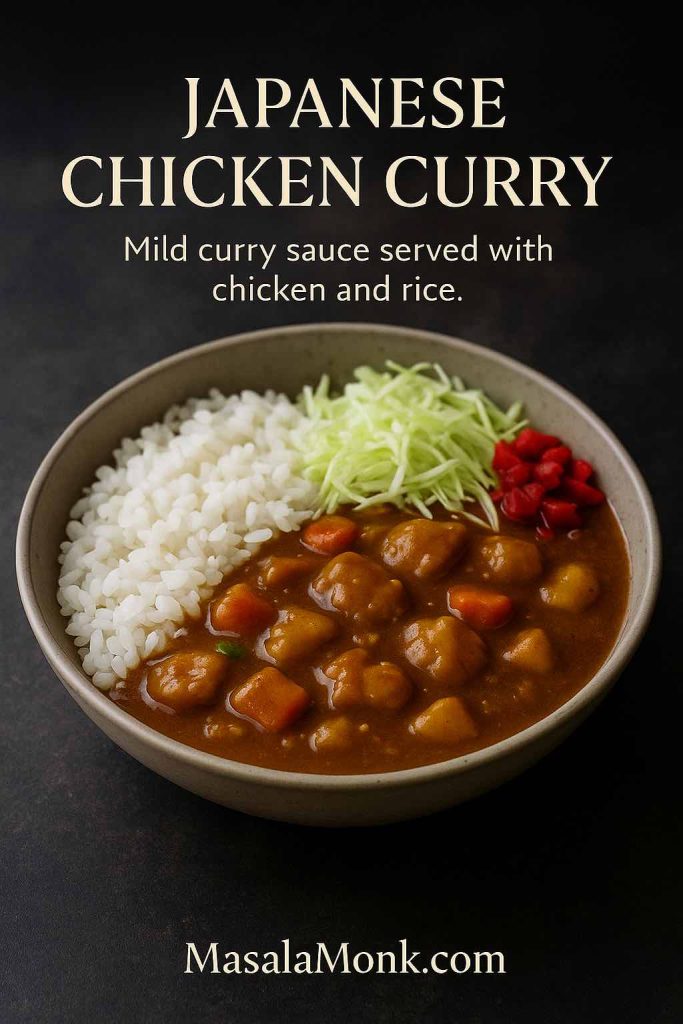
Instead of breading the chicken:
- Cut the raw chicken into bite-sized pieces.
- After the onions, carrots and potatoes have simmered for about 5 minutes in the curry base, stir in the chicken.
- Simmer for another 10–15 minutes, until the chicken is just cooked and the sauce is thick.
You lose the crunch, but you gain a one-pot comfort bowl that sits somewhere between Japanese curry and Indian-inspired dishes like a lighter spinach chicken curry.
Recipe for Slimmer “fakeaway” chicken katsu curry
If you’re tracking calories or simply don’t love the idea of deep-frying on a Tuesday night, a slimmer version keeps the flavour but trims the excess.

You can:
- Air-fry or oven-bake the breaded cutlets on a rack, using oil spray instead of pouring centimetres of oil into a pan.
- Drop the oil in the curry base to 1 tablespoon and rely more on stock and vegetables for body.
- Serve with extra shredded cabbage and steamed vegetables, and slightly reduce the rice portion.
On weeks when you’re deliberately alternating richer dinners with lighter ones, you might pair this “fakeaway” with a genuinely lean meal on another night, such as a Kerala-style coconut vegetable stew or a big pot of authentic Punjabi rajma.
Vegetarian and vegan katsu curry
Katsu doesn’t have to mean meat. In fact, the structure of this dish lends itself beautifully to vegetarian and vegan cooking.
Tofu katsu
- Press firm tofu for at least 20–30 minutes to remove excess moisture.
- Slice into slabs about 1.5 cm thick.
- Season lightly with salt and a splash of soy sauce.
- Dust with flour, dip into a plant-based milk and flour mixture or aquafaba instead of egg, then coat in panko and fry or air-fry.
Serve the tofu katsu over the same curry sauce made with vegetable stock, and you have a fully meat-free plate that still delivers serious crunch.

Vegetable katsu
Root and starchy vegetables make wonderful katsu bases:
- Thick slices of aubergine
- Rounds of sweet potato or pumpkin
- Sturdy slabs of celeriac
Par-cook them briefly in boiling water or the steamer if they’re very firm, then cool, bread and fry. The sweet, soft interior surrounded by crisp crumbs is addictive.
For readers who are exploring plant-based eating more broadly, it’s worth looking at seitan and other high-protein meat alternatives. Guides like the one on seitan as “the vegan’s chicken” show just how many curry-style dishes can be made without animal protein at all.
Also Read: ‘Tofu’ Instead of ‘Eggs’: 5 High Protein Plant-Based Breakfast Ideas
Sauce options: scratch, roux blocks and katsu dipping sauce
Many people first fall in love with this dish because of the sauce. It’s gentle, cosy and not as fiery as some Indian curries, which makes it ideal for families and spice-shy eaters.
Fully from-scratch Japanese curry sauce
The version at the start of this post is already close to a scratch sauce: you’re making a roux in the pan, then adding stock and flavourings. To lean even more into that direction, you can:
- Toast whole spices like coriander, cumin and black pepper gently before grinding them.
- Add a teaspoon of tomato paste with the garlic and ginger for deeper colour.
- Stir in a little grated dark chocolate or a dab of miso at the end for extra umami.
Food writers who specialise in Japanese home cooking, like those behind RecipeTin Japan, often mention how this style of roux-based curry evolved from European-influenced cooking in the late nineteenth century. Today, it feels as firmly Japanese as miso soup or ramen.
Using Japanese curry roux blocks
On busy nights, it’s absolutely fine to lean on curry blocks. The technique is slightly different:
- Sauté onion, garlic, ginger and vegetables as before.
- Add stock and simmer until the vegetables are almost tender.
- Turn off the heat and stir in rough chunks of curry roux until they dissolve completely.
- Turn the heat back on and let the sauce bubble gently until thick and glossy.
Different brands offer varying levels of spice and sweetness, so you may find one that becomes “your” flavour. You can still customise it with a splash of soy, a little grated apple or a pinch of garam masala.
Simple katsu dipping sauce
Sometimes, when people search for a chicken katsu curry recipe, what they really want is the crispy cutlet with a thick, tangy brown sauce rather than the full curry. That sauce is tonkatsu or katsu sauce, and it’s very easy to replicate at home.
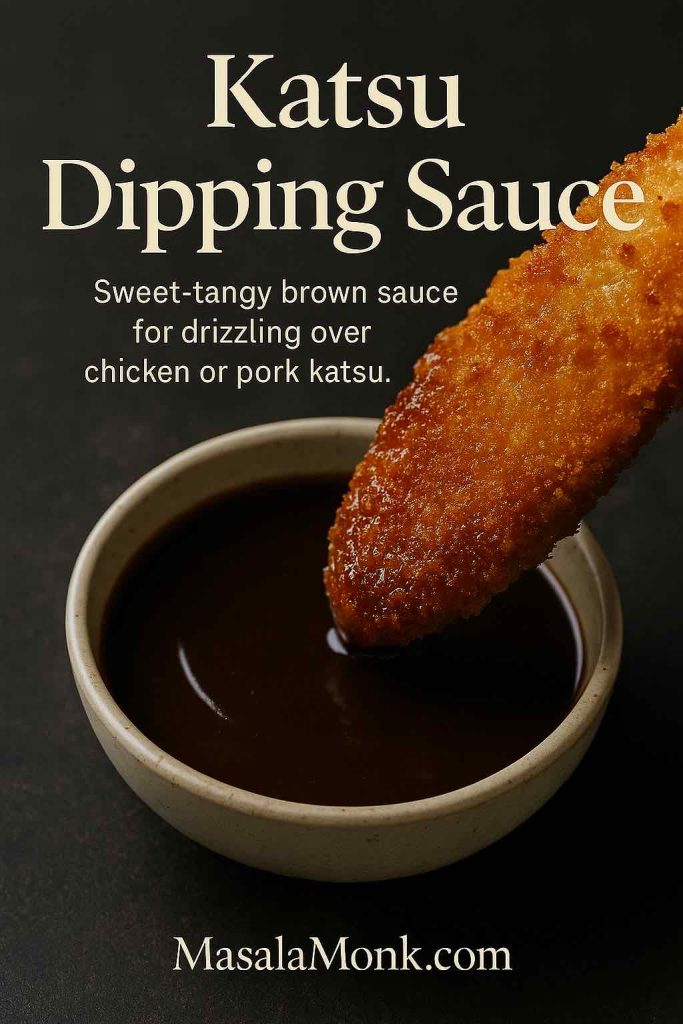
Stir together:
- 2 tablespoons ketchup
- 1 tablespoon Worcestershire sauce
- 1 teaspoon soy sauce
- ½–1 teaspoon sugar or honey
- Optional: a tiny splash of rice vinegar or lemon juice
Taste and adjust until it’s sweet-tangy and savoury. This is perfect drizzled over sliced katsu, whether you’re serving it with curry or simply over a bowl of rice and shredded cabbage.
Also Read: Mustard Fish Curry Bengali Style (Shorshe Bata Rui Maach)
What to serve with chicken katsu curry
Because this dish is already a full meal in a bowl, you don’t need elaborate side dishes. That said, a few smart additions can turn dinner into more of a Japanese-inspired feast or an easy weekend gathering.
Fresh, cooling sides
Shredded cabbage and pickles are the traditional companions, but you can easily widen the spread.
A crisp salad with a yoghurt-based dressing works beautifully. For instance, you could borrow the idea of a garlicky, herb-heavy yoghurt from a mezze table and adapt it to your pantry. If that appeals, you might enjoy exploring a master recipe like the one for Greek tzatziki with ten variations, then adjust the herbs and garlic to suit your katsu night.
On evenings when you’re hosting a group and want nibbles on the table while the curry simmers, a warm bread and dip platter works nicely. Something like a spinach dip collection with cold and baked options gives guests something to scoop up with bread or veggie sticks while you focus on slicing katsu.
Drinks that pair well with katsu curry
Rich, fried food is often happiest next to drinks that are bright, slightly acidic or effervescent.
If you enjoy cocktails, a citrus-forward gin drink can cut right through the creaminess of the curry sauce. A set of creative gin cocktail recipes gives you plenty of options, from herbaceous to lightly sweet, so you can choose something that suits the mood.
For brunchy or celebratory lunches, leftover katsu can top rice bowls or even appear beside scrambled eggs. In that case, a sparkling drink like a mimosa fits the vibe. A guide to ten easy mimosa variations shows how quickly you can shift from classic orange to seasonal twists like apple or berry.
If you prefer something bolder and tomato-based, especially on a lazy weekend, a well-made Bloody Mary is another fun option. A recipe collection that covers classic, tequila-based and virgin Bloody Mary versions lets everyone at the table pick their own level of kick and alcohol.
Desserts that follow katsu curry beautifully
After a salty-sweet, savoury meal like this, a cool and milky dessert is incredibly satisfying. One excellent option is a slice of tres leches cake: soft sponge soaked in three kinds of milk, chilled and topped with whipped cream. The gentle sweetness and cold temperature balance the warmth and spice of the curry.
On cooler days, you might lean towards baking that fills the kitchen with warm spice. Having a jar of homemade pumpkin pie spice ready makes that as simple as stirring a spoonful into your batter. A guide to mixing your own pumpkin pie spice blend shows how to get the cinnamon-nutmeg-ginger balance just right.
Also Read: Baked Jalapeño Poppers (Oven) — Time, Temp & Bacon Tips
Make-ahead, freezing and leftovers
One of the biggest advantages of mastering a detailed chicken katsu curry recipe is that it’s extremely meal-prep friendly. A little planning turns a single cooking session into multiple easy meals.

Freezing katsu for later
You can freeze katsu either before or after cooking:
- Before frying
- Bread the chicken as usual.
- Arrange the cutlets in a single layer on a tray and freeze until solid.
- Transfer to freezer bags or containers with baking paper between layers.
- Cook from frozen in the oven or air fryer, adding a few minutes to the cooking time.
- After frying
- Let the cooked cutlets cool completely.
- Wrap each one tightly or place in an airtight container.
- Reheat in the oven or air fryer until hot and crisp again.
The key is to avoid microwaving, which tends to make the crust soggy.
Storing and reheating the curry sauce
The curry sauce keeps well:
- In the fridge: up to 3–4 days in a sealed container
- In the freezer: up to 1–2 months, ideally in portioned tubs
When reheating, warm gently over low heat, adding a splash of water or stock if it has thickened in the fridge.
Turning leftovers into new meals
Leftover components are a gift. A few ideas:
- Katsu rice bowls
Warm the curry and rice, then reheat sliced katsu in the oven or air fryer. Finish with a soft-boiled or jammy egg (an air fryer makes those straightforward; recipes for air-fried hard-boiled eggs walk you through timing and peeling tricks). - Breakfast with a twist
The morning after a rich dinner, you might want something lighter but still satisfying. High-protein overnight oats with multiple flavour variations are simple to prep in jars while the curry simmers; then breakfast is sorted for the next day or two. - Second-day curry night
Use leftover curry sauce as a base and add new ingredients: chickpeas, roasted vegetables, or seared paneer. You can even pour it over crisp roasted potatoes for a Japanese twist on curry chips, though you may find you don’t miss the chips at all once you’ve fallen in love with katsu.
If your overall routine includes training, fasting days or careful hydration around heavier meals, there’s room to think about drinks as well as food. Homemade electrolyte mixes, such as the ones in MasalaMonk’s recipes for natural electrolyte drinks or fasting-friendly electrolyte blends, can sit in the fridge ready for gym sessions or long walks.
A brief look at katsu curry’s journey
To round things out, it’s worth taking a step back and appreciating how this humble plate of rice, curry and cutlet travelled so far.
Historically, Japanese curry itself is a product of global zigzagging. Articles like the one on how India gave Japan its beloved katsu curry describe how British naval officers introduced an Anglicised form of Indian curry to Japan in the late nineteenth century. Japanese cooks then adapted it, thickening the sauce, toning down the heat and eventually turning it into something that feels distinctly Japanese.
Katsu, on the other hand, came from Western cutlet culture. When those two strands met on a plate at places like Grill Swiss in Ginza, the result was a dish that bridged European technique and Japanese comfort. Writers at Food Sake Tokyo talk about how katsu curry became popular with students, office workers and families precisely because it was affordable, filling and easy to serve from canteens.
Later, as Japan’s food culture spread abroad, katsu curry became a kind of ambassador dish, particularly in the UK where fast-casual restaurants turned it into an icon. The story of that journey is laid out in JETRO’s piece on katsu curry taking over British menus, and you can see its influence every time a non-Japanese restaurant lists “katsu” as shorthand for “Japanese-ish curry.”
Cooking it at home, though, brings the focus back to what made the dish appealing in the first place: the tactility of breading and frying, the inhale of curry steam when you lift the lid, the first bite where crisp crumb, soft rice and velvety sauce come together.
Bringing it all together
By now, you’ve seen that a chicken katsu curry recipe is really a template:
- A comforting Japanese curry sauce, built either from scratch or with roux blocks
- A crisp, breaded cutlet – chicken, pork, tofu or vegetables
- A bowl of rice and a handful of crunchy toppings to tie it all together
Once you’ve cooked it once, you can improvise almost endlessly: swap in air-fried cutlets for a lighter take, lean into vegetarian versions, or double the curry and freeze half for an easy future dinner. You can follow it with Indian favourites like creamy butter chicken on another night, or pivot into cocktails and dessert with a lemon drop martini and a tray of tres leches cake when you’re feeding friends.
Most importantly, this is the kind of dish that rewards repetition. The second or third time you make it, your hands move more confidently: you salt the rice water without thinking, you know exactly when the curry is thick enough, and you recognise the moment the katsu turns the right shade of gold. That’s when a recipe stops being just words on a screen and becomes part of your personal kitchen repertoire—ready to be pulled out whenever you want the table to go a little quiet on the first bite.
FAQs about Katsu Curry Recipe with Chicken
1. What is chicken katsu curry, exactly?
Chicken katsu curry is a Japanese-style dish made of three parts: a crispy breaded chicken cutlet (chicken katsu), a thick and mildly spiced Japanese curry sauce, and steamed rice. In a classic chicken katsu curry recipe, the cutlet is sliced and served on top of rice, with the curry ladled to one side so the crumbs stay partly crisp while still soaking up the sauce.
2. Is chicken katsu curry Japanese or Indian?
Chicken katsu curry is considered Japanese, although the curry itself was originally inspired by Indian flavours that arrived via Britain. Over time, Japan developed its own curry powder blends, curry roux blocks and a characteristic thick, mellow sauce. As a result, a chicken katsu curry recipe today tastes very different from most Indian curries, with less heat and more comforting sweetness.
3. How spicy is a typical chicken katsu curry recipe?
Generally, chicken katsu curry is mild to medium in heat. Japanese curry powders and roux mixes are often sold in mild, medium and hot versions, but even the hot styles are usually gentler than many Indian or Thai curries. If you prefer a mild chicken katsu curry, use a mild curry powder and skip extra chilli; if you enjoy more kick, add chilli flakes, fresh chillies or a hotter curry powder while still keeping the sauce thick and cosy.
4. Can I make chicken katsu curry without deep frying?
Yes, absolutely. A chicken katsu curry recipe works very well with air-fried or oven-baked cutlets instead of deep-fried ones. Coat the chicken in flour, egg and panko as usual, then bake on a rack or cook in an air fryer with a light spray of oil until golden and cooked through. This method keeps the katsu crunchy but uses far less oil, which suits anyone looking for a lighter version or a “fakeaway” style katsu curry at home.
5. How do I make katsu curry sauce from scratch?
To make katsu curry sauce from scratch, start by slowly frying sliced onions in a little oil or butter until soft and lightly golden. Next, add garlic, ginger, carrots and potatoes, then sprinkle over flour and curry powder to form a simple roux. Gradually whisk in stock, then season with soy sauce, a touch of sugar or honey and a little grated apple. Simmer until the vegetables are tender and the sauce is thick and glossy. This forms the heart of any homemade chicken katsu curry recipe.
6. Can I use curry roux blocks, powder, paste or cubes for katsu curry?
You can use any of these, as long as you adjust the liquid and seasoning. Curry roux blocks and cubes are the most traditional for Japanese curry; they already contain flour, fat and spices, so you just dissolve them into stock after sautéing your vegetables. Even curry powder works well if you cook it with flour and oil to form a roux. You can pick up curry paste as well, which is stronger, so use less and balance it with extra sweetness and stock. In every case, taste the katsu curry sauce towards the end and adjust thickness and flavour so it coats the back of a spoon.
7. How can I make a healthier or Slimming World–style chicken katsu curry?
A lighter chicken katsu curry recipe focuses on reducing oil and increasing vegetables. First, bake or air-fry the breaded chicken instead of deep frying it, using oil spray instead of submerging it in oil. Second, use a smaller amount of fat in the curry base and rely on onions, carrots and potatoes for body, boosting flavour with stock, soy and spices rather than cream. Finally, serve the curry with extra shredded cabbage or steamed vegetables and a slightly smaller portion of rice. These small shifts keep the katsu experience but bring the meal closer to Slimming World–style “fakeaway” comfort food.
8. How do I make vegetarian or vegan katsu curry?
To make vegetarian or vegan katsu curry, replace the chicken with tofu or vegetables and use vegetable stock in the curry sauce. For tofu katsu, press firm tofu, slice it into slabs, then bread and fry or air-fry it just like chicken. If you are making vegetable katsu, use slices of aubergine, sweet potato or pumpkin. And for a fully vegan version, swap the egg wash for plant milk mixed with a little flour or use aquafaba (chickpea water) to help the panko stick. As long as you check that your curry roux or powder contains no animal products, you can enjoy a plant-based katsu curry that still feels indulgent.
9. Can I use pork or other meats instead of chicken in this katsu curry?
Definitely. In fact, pork katsu curry (tonkatsu curry) is probably the most common version in Japan. Simply substitute chicken with boneless pork loin or fillet, pound it slightly, then bread and cook in the same way. You can also adapt the method for turkey, firm white fish or even prawns, although you may need to tweak cooking times. Since the curry and rice remain the same, changing the protein is a simple way to create new meals from the same basic katsu curry recipe.
10. What are the best chicken cuts and breading tips for katsu?
Chicken breast is the most popular choice for katsu because it pounds out evenly, slices neatly and cooks quickly. However, chicken thigh cutlets give a juicier result if you don’t mind trimming them a bit. For breading, start with well-dried, evenly pounded pieces, then follow a flour–egg–panko sequence. Press the crumbs on firmly and let the coated chicken rest for a few minutes before cooking so the breading adheres. This approach gives a crisp, even crust that doesn’t slide off when you slice the katsu for your curry bowl.
11. Can I freeze chicken katsu curry and how should I reheat it?
You can freeze both components, but it’s best to freeze them separately. Freeze the breaded chicken either raw (before frying) or cooked and cooled; in both cases, reheat in an oven or air fryer so the crust becomes crisp again. Freeze the curry sauce in containers, leaving a little space at the top, and defrost it gently on the stove, adding a splash of water or stock if it has thickened. When you’re ready to eat, warm fresh rice, reheat the katsu and curry, and assemble as usual. This way, a homemade chicken katsu curry recipe becomes an easy grab-from-the-freezer dinner.
12. Is chicken katsu curry halal and how can I adapt it?
Chicken katsu curry can be halal as long as all ingredients meet halal requirements. Use halal-certified chicken, ensure the stock contains no non-halal meat or alcohol, and avoid adding mirin or sake to the curry sauce. The breading ingredients (flour, eggs, panko) are usually fine, so the main considerations are the meat and any liquids used for flavour. Once those are checked, the rest of the chicken katsu curry recipe can stay the same, giving you a halal-friendly version of this Japanese comfort dish.









